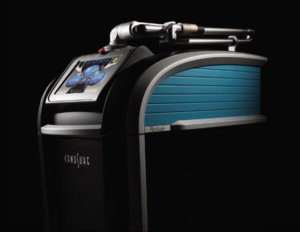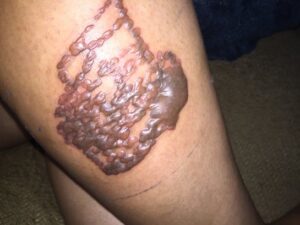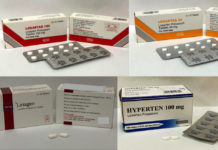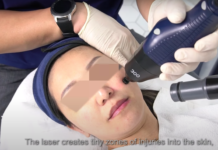
Tattooing is a growing industry, estimated to be worth USD $3 billion a year in the USA alone. Tattoos are permanent, when ink is inserted into the dermis of the skin. However, the permanent nature of tattoos mean that some of us might want to remove them some years after getting them done. Therefore, the demand for tattoo removal has also increased over the years, along with increased tattooing.
Tattoo Removal Methods
Because tattoo ink is inserted under the skin, removing them is actually more complicated than getting them done. Tattoo removal has come a long way. One of the oldest ways of removing tattoos was to excise the tattooed area, or to use dermabrasion to abrade the tattoo away. Attempts have also been made by injecting solutions under the skin, or using chemical peels – These are often not very effective, and may even result in disfiguring scars.

With lasers, tattoo remover is now much easier. Q-switched lasers, such as the Revlite, have been used to remove tattoos for more than 30years – with good success. The laser causes the tattooing to fragment under the skin, allowing for easier removal by our skin cells. However, problems remained with the older lasers – results can be inconsistent, and there was often collateral heating of the skin which resulted in side-effects such as blistering and scarring. This is why the picosecond lasers were born – with the intention of improving the results of tattoo removal.

PicoSure – The first Picosecond Laser
The PicoSure laser was approved by the FDA in 2013 for the removal of tattoos. Manufactured and developed by Cynosure based in Massachusetts, United States, it was the first Picosecond laser to be approved for this purpose. It was also the world’s first picosecond laser, opening doors which allowed doctors to now treat pigmentary conditions and provide overall skin rejuvenation more effectively than before.
Following the Picosure, many other Picosecond lasers have been produced, however, there are significant differences – The Picosure is the only laser that emits laser light at 755nm, rather than 1064nm like the other Picosecond lasers. This has significant therapeutic effects when it comes to tattoo removal, which I will describe later.

Tattoos Are Not Created Equal
How easy or difficult it is to remove a tattoo depends on several factors, one of the most important being the colour of the tattoo. Different colour pigments respond to different light wavelengths. Black inks are the easiest to remove because black pigments absorb the laser most easily, followed by red darker shades of blue. Light green and neon colours are the most challenging to remove. Blue and green inks do not respond well to 1065nm – the wavelength of all other people is this. They respond best to the Picosure wavelength of 755nm (red coloured laser light)
There are also a number of other factors that can determine how stubborn tattoo inks can be:
SKIN COLOUR Your skin colour plays an important role in determining if your tattoo can be easily removed. The laser works by breaking down the ink colour if the contrast between the ink and your skin colour is huge. This means that black ink on fair skin would come off more easily than darker colours on tanned skin.
AGE OF TATTOO The older the tattoo, the easier it is for the laser to break down the ink pigments. This is because the ink in older tattoos have had more time to disperse and move towards the surface of the skin.
QUALITY OF TATTOO Good quality tattoos are more difficult to remove as compared to a tattoo done by an amateur. If done by an experienced tattoo artist, the ink is often placed deeper int the skin with more ink colours of better quality used in a single session. Therefore, doctors have found that removing tattoos by experienced tattoo artists are generally more tedious.
TYPE OF LASER In the past, there was no laser machine that can remove all ink colours. Most traditional lasers can only effectively remove darker hues while lighter tattoos remain a challenge.

PicoSure Removes All Tattoo Colours – Almost
The PicoSure laser is the only laser with 532nm, 755nm and 1064nm wavelengths, making it the only laser that could remove almost all tattoo ink colours. It effectively targets tattoo ink across all skin types, without harming the surrounding skin. This is a particularly important property when treating darker Asian skin.
During treatment with the PicoSure, ultra-short pulses target tattoo ink particles with PressureWaveTM technology. The pressure is so powerful that it shatters the tattoo ink into tiny dust light particles. The particles are then eaten by scavengers cells in the skin known as macrophages, and naturally eliminated from the body. The process can take up to 6 months after a single treatment.
In my practice, the PicoSure laser 755nm wavelength is my workhorse for treating tattoos. It is indispensable for treating the normally very hard to treat colours – blue, purple, green tattoos, which I could not treat effectively until I started using the Picosure.
From my own experience, the PicoSure is also excellent for removing black tattoos, requiring fewer treatments and having fewer side effects that the Q-switched lasers. In particular, I used to have a problem of being unable to remove remnant tattoo inks with the Q-switched laser, and I found that the PicoSure excels at mopping up the last bit of tattoo ink with the traditional lasers had difficulty removing.
There is one colour tattoo ink which still remains elusive – skin-coloured tattoos. Because the tattoo ink is so close to our skin colour, it is very difficult for any laser wavelength to effectively target it. Therefore, please think twice before you decide to get a tattoo with beige or skin colours in it.

Tattoo Removal is Expensive, but PicoSure Will End up with Cost Savings
The number of laser treatment sessions needed to remove a tattoo depends on many factors, as described above. On average, it mostly takes 5 to 8 sessions, spaced 4 to 8 weeks apart, to successfully remove a tattoo. The long treatment interval is needed to allow your skin to rest and for the shattered ink particles to be completely metabolised.
It is difficult to provide an estimated price of the treatment because it depends on the area of the body and the size of the tattoo, but in general, a small area of about the size of a credit card will set you back by about S$250 to S$300. A large area about the area of half a back will cost S$1,500 to S$2,500 per session of PicoSure laser. The good news is that with the PicoSure laser, fewer sessions of tattoo removal will be required so you actually save money overall.
Please seek a consultation with your doctor to find out the type of laser which is best for your tattoo, and the cost involved. Removing a tattoo can be a long process, so you will need to work out a treatment plan and make sure that the entire tattoo removal journey is within your budget before making a commitment.




















